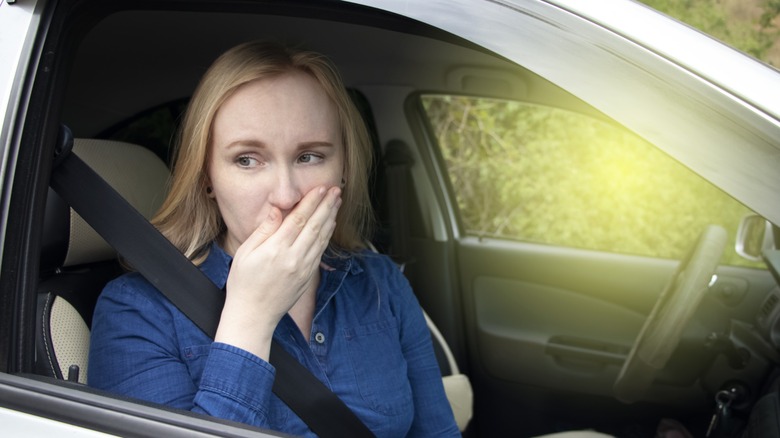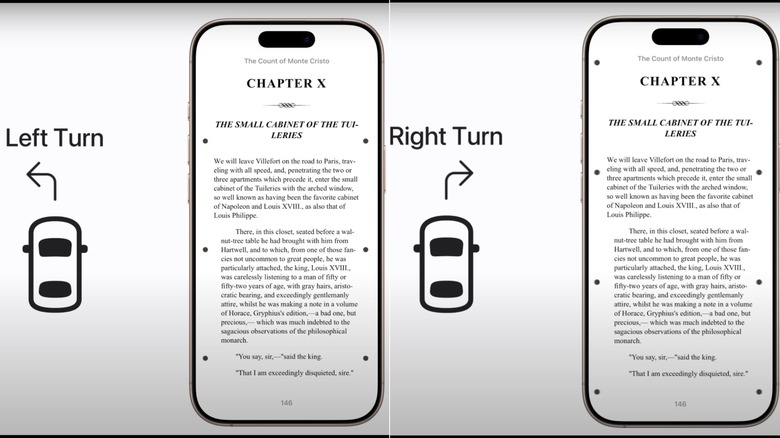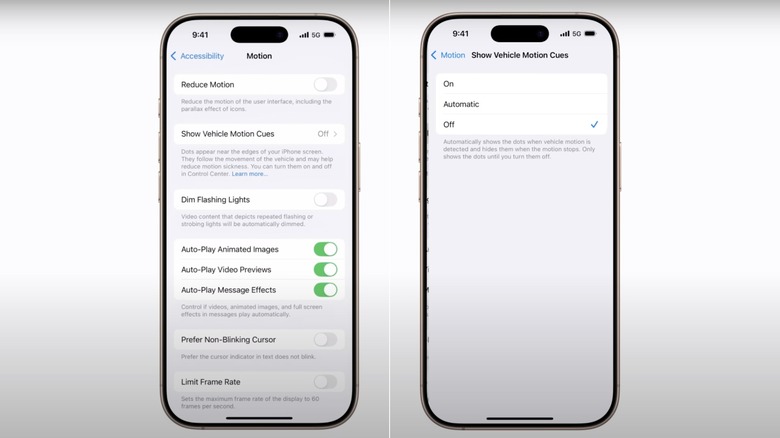Do You Get Car Sick Looking At Your iPhone? This Hidden Feature May Help
It's a cliche, but it's one of those cliches that is often true: you're always looking at your phone. Whether it's scrolling social media, checking work emails, or brushing up on current events, a lot of screen time involves reading and, for many of us, this can be a problem when we're riding in a car. You may be well aware of this issue or perhaps you never really thought about it before, but looking at your smartphone in a moving vehicle can induce motion sickness — especially if you're reading text. This can be very uncomfortable and for some people, it makes them so car sick that using their phones just isn't possible.
As of 2024, however, you can utilize an underrated iPhone feature that everyone should be using: Vehicle Motion Cues. This accessibility setting will sense when you're in a moving vehicle and then automatically activate, displaying moving black dots across your screen. While using your iPhone with these superimposed circles, you'll likely feel less car sick and your motion sickness may even disappear entirely. Vehicle Motion Cues debuted with iOS 18 and can also be used with the iPad. It will soon be available on MacBooks and other macOS devices as well. With one simple feature, Apple has allowed many car sick users to turn their vehicle into a mobile office, and all it took was a few moving dots.
How does iPhone's Vehicle Motion Cues work?
Phone-induced motion sickness isn't psychosomatic— there's science behind why you start feeling nauseous. Your body is stationary inside a car but everything around you is moving, which sends conflicting signals to your brain — are you moving or aren't you? This muddling of sensory input can cause nausea as it messes with your equilibrium. It's the same principle behind seasickness and motion sickness on planes and trains. It's also why using virtual reality can be difficult without employing ways to reduce motion sickness when using VR.
Plus, car sickness can be exacerbated by reading text or looking at static images on your phone, because your eyes are focused on stationary objects while buildings, people, and other vehicles fly by in your peripheral vision (or if you're constantly looking back and forth between your phone and your surroundings). On your iPhone, you can either manually turn on the Vehicle Motion Cues feature or set it to automatically activate when your device detects that you're in a moving car using its integrated sensors, like accelerometers and gyroscopes.
When Vehicle Motion Cues is activated, a series of black dots will display on your screen, originating near the edges. These dots are superimposed over whatever you're looking at, though are small enough to not be that intrusive. More importantly, these dots will move, roughly mimicking the motion of the vehicle you're riding in, going up and down and left and right as the car accelerates, brakes, and turns. While you're looking at fixed text and images on your phone, these animated dots remind your brain that your body is, in fact, moving. As Apple puts it, the dots "represent changes in vehicle motion to help reduce sensory conflict without interfering with the main content."
How to use Vehicle Motion Cues on your iPhone
Because Vehicle Motion Cues launched on iOS 18, it can only be used on devices compatible with the operating system, such as the futureproofed iPhone 16 Pro. Vehicle Motion Cues won't work on the iPhone X or any devices older than that. Here's how to activate Vehicle Motion Cues on your iPhone:
- On your iPhone's Settings app and tap Accessibility.
- Tap Motion.
- Tap Show Vehicle Motion Cues.
- Tap Manual if you immediately and permanently want it on, even if you're not riding in a car. Tap Automatic if you only want the dots to appear when you're in a moving vehicle.
So does Vehicle Motion Cues actually work? Many users say it does. On r/apple, redditors say the feature "works and it's quite amazing," with one commenter reporting that they activated it "in rough seas and while riding a bus with adventurous drivers, and it makes a huge difference for me." A motion sickness sufferer on r/iOS declares, "I was pleasantly surprised to see how well this worked."
Everyone's brains work differently though, and the feature hasn't worked for everybody. There's also a risk of amplifying your motion sickness, as one scientist explains to Self: "The last thing you want is to add another confusing sensory input that's not accurate. Presenting visual cues that aren't perfectly matching the motion could technically make symptoms worse." But based on online chatter, it seems to work for many iPhone users. Also, Apple reminds users what should be obvious: you shouldn't use Vehicle Motion Cues when you're the one actually driving the car, since you shouldn't be on your phone in the first place. (Keeping your eyes on the road isn't just common sense — it will also help keep you from getting car sick.)


